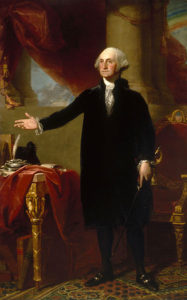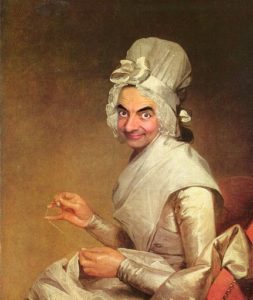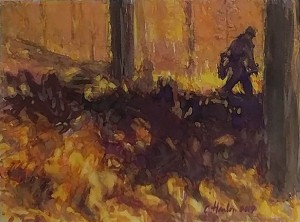Dear Artist,
You’ll be glad to know this letter has nothing to do with not talking about your art. It has to do with the business of painting people with their mouths closed. While a toothy smile may suggest desirable qualities like a happy nature and a sense of humour, in painted portraits it may not be such a good idea. We need look no further than George Washington for this convention. In 1789, when Washington was 57 and inaugurated as president of the U.S., he had only one of his original teeth left. The late Dr. Reidar F. Sognnaes was a scholar in the field of oral pathology at the University of California School of Dentistry in Los Angeles. “In the good old days, teeth were lousy,” said Dr. Sognnaes. “Washington suffered such dental agony that he hardly ever laughed through his two terms. He could not pronounce lengthy words or words with “S” sounds, and he was able to eat only soft foods.”
When you look at the work of the great portraitists of old — Gainsborough, Rembrandt, John Singleton Copley, John Singer Sargent and Gilbert Stuart, who painted Washington, there’s nary a tooth to be seen. Stuart’s lifetime oeuvre, for example, seems a paean to lockjaw. Goodness knows the condition of bicuspids in Renaissance Italy. Can you imagine Mona Lisa with a toothy grin?
In the history of portraiture, a few exceptions can be seen. Velasquez and Franz Hals painted jesters and stupid people with open mouths. To this day most portraitists generally keep their subjects in the closed position. There may be a message in this. “Smile,” “Whiskey,” “Cheese,” and other mouthy encouragements are calls reserved for photographers, except in the case of rock musicians where it’s important for people to think rock’s a serious business. Fact is, if you paint a picture of someone with a smile, it’s almost a sure sign it was copied from a photo. If you do try painting an openmouthed sitter over an extended time, she’ll dry out on you and you’ll start to get an irked look that’s less than flattering. On the other hand, if your idea is to make people look irked, by all means insist that they smile.
Best regards,
Robert
PS: “A portrait is a painting of a person with something wrong with the mouth.” (John Singer Sargent)
Esoterica: If you do paint teeth, you may need to gloss them over and blur them a bit. Portraits don’t usually look so hot when the teeth are painstakingly correct. For some reason carefully delineated teeth tend to look like false teeth. False teeth from Dr Sognnaes’ collection are on display at UCLA. In the good old days the rich and famous had teeth made from the darnedest things. George’s included carvings from elephant and walrus tusks as well as the teeth of cows, hippos, and people. Apparently a difficult mouth to fit, some of his teeth had to be held in place with springs. Contrary to popular belief, none of George’s teeth were made out of wood. The wooden ones were reserved for senators and congressmen.
This letter was originally published as “The closed-mouth convention” on December 7, 2012.
Have you considered a Premium Artist Listing? With each letter, an artist is featured at the bottom of this page. The Premium Artist Listings are a means of connecting artist subscribers through their work. Proceeds from each listing contribute to the production of The Painter’s Keys.
Art lives from constraints and dies from freedom. (Leonardo da Vinci)
Featured Artist
Christine Hanlon, whose work has been compared to that of Edward Hopper, creates ‘urban landscapes which quietly exude atmosphere.’








24 Comments
This is a good one! Thank you for the humor too!! Our informal portrait group insists on no teeth and no hands! (Pre-COVID of course!).
If only the Marketing gurus and Ad agencies paid attention to this simple principle. It seems everyone in commercials these days has a fixed ‘cheesy grin’ regardless of what they’re doing or the product in question. No doubt the idea is to show a ‘satisfied customer’ pleased with the product or service being promoted. It supposedly is intended to ‘send a positive message’, but most of the time it just looks…stupid. Nobody smiles when they’re, for example, changing a light bulb. Nobody smiles while they’re eating their breakfast, no matter how much they enjoy their cereal. Evidently the principal skill required by on-camera spokespersons in commercials is their ability to speak while simultaneously grinning like the proverbial Cheshire cat. Aside from looking unnatural, it’s also remarkably difficult to do.
I’d go further, John. What about the TV presenters? Their face often seems to be locked in a permanent grin even when presenting a serious programme – science for example. What’s wrong with these people? Don’t they realise life is no laughing matter? Grrr!
I smile when I change a lightbulb, John, but no-one can see me because it’s dark. Until there is light. Then I go back to my usual grumpy self. :)
I totally get it. The portraits that I like to paint do show some teeth but that is because, like you have already stated they are from photographs. I like to capture people at work, doing something specific and many of them do smile for the camera. Sorry can’t help it. I paint the grin, smile, smirk, whatever you call it.
Thanks John, I’ll be looking for false teeth everywhere on TV now. The newscasters all seem to have pretty fancy teeth. But those folks they are interviewing–holed up in some university office or their dining room–they probably still have their own. I often sketch these folks while watching TV, and usually without a smile. The mouths are moving too much. Nostrils are another issue when I draw. Don’t want to make folks look like a pig.
I am a retired art teacher and I draw and paint portraits. I use photos to work from but before photography the only way to do a portrait was to have the subject “sit” for you numerous hours in the same position without moving. A person can not hold a smile for more than a moment and when they do try, the smile quickly goes into a grimace. I know dental hygiene was pretty horrible many years ago but even if a person did have reasonably good looking teeth a portrait painter could never had painted an effective painting of the person smiling. Therefore all of us who have seen the Master’s paintings came to know that an artist’s portrait never (or rarely) had a person smiling. That is why one today seems inappropriate or artificial looking. I guess what I am saying is that although people 100-250+ years ago had bad teeth, it was probably not the reason we always see portraits from the past with subjects not smiling.
Love this quote: “Art lives from constraints and dies from freedom.” from Leonardo… Makes me wonder about some of the art we see today.
I think this is a time truth but the opposite is truth today. Sometimes there is no truth or any sense of good nor bad nor rules nor freedom!
Interesting article…I just did a charcoal painting of my daughter-in-law with her now deceased best pal BO a great dane. It came out almost perfect except I used a photo and my daughter-in-law had a slight smile that I tried to duplicate…i kept looking and looking and something just didn’t look right. I am getting ready to mail this to her for Christmas and came upon this article. Guess I still have some work to do because she spent a lot of money and pain on those teeth…wouldn’t want to screw them up…Guess I need to take out my soap eraser and get to work. Thanks for the info…always appreciate your messages.
laughter is the best thing in life ,With out it would be a very sad world
This is Bob’s humor at its best, delivered with a lesson in portraiture. Thank you for brightening my day, Sara!
I love the John Singer Sargent quote and use it a lot. I remember this letter too.
About hands- it is quite possible to get a good rendition of hands by themselves, either in paint or line, but it is really difficult to get good ones in the same space with the face. Then to get the connecting parts right takes real skill. It is then a portrait?
I understand that only the upper-class had terrible teeth! Why? They were the only ones that could afford sugar.
I can’t tell you how many times I have tried to explain this “toothy smile problem” to subjects who ask me to paint from photographs. All those lovely white teeth tend to take over the painting. Since most of us do not have the luxury of the numerous sittings required to paint from life it is just another problem we have to deal with. It’s a delicate adjustment to take just enough of the glaring white away and still have a pleasant smile. The good news is that if the likeness is there and the setting is effective the teeth can be dealt with. I let my subjects know starting out about the problem. They want a memory of a person or time and they are not art critics. Portraits from photographs can be very satisfying.
Love the Mr Bean painting! Thank you from the very bottom of my shoes!
I once had a wonderful time painting a broadly smiling subject, a young man who sat for me for 3 1/2 hours and wanted to give his portrait, a mask of his face, to his grandmother. He wanted her to see his glorious smile in her parlor every day. I warned him that it would be difficult for us both. He insisted. With a few breaks and me painting as fast as i could, we succeeded admirably! It was a lot of fun, too!
Teeth and the “whites” of the eyes are very near the skin color. I have successfully done a “half smile” by putting in a light shadow from the lips – top and bottom – and blurring the lines between the teeth – just a suggestion.
I learned the hard way, no teeth. My favorite mixologist on a cruise cajoled me into painting her portrait from a photo.
She has a magnificent smile and I tried to capture that on several tries between cruises. Finally I came up with one that I did not myself particularly like, with an open mouth smile . I gave it to her on the very next cruise and with a look of disgust, she promptly handed it back. My drinks have never been the same on that cruise since.
Portraits are just hard. People sitting for you soon lose all animation in their face, looking blankly into the middle distance and bored stiff. It shows. On the other hand painting from photos can look flat. Sooo…..
I have never commented in all the years I have been receiving these lovely articles, whether I agreed or disagreed. However, I guess I must REALLY disagree here! Although it is true that a portrait painted exclusively from life cannot possibly incorporate a genuine smile for the reasons so logically explained in other comments. But I daresay, they are thin on the ground, those portrait artists that do not use at least some photographic back-up, if only to relieve their subjects of the tedium of sitting. And I also believe that since we live in an age of the wonderful technology of the camera, which can capture and hold a moment in time, why not use it as an aid, after studying the spontaneity of life? In my own work, my highest calling is to portray moments of happiness, joy, and good cheer, because God knows, there’s enough of the other stuff out there. And at the risk of appearing arrogant and self-serving, I am including some links to my own work (mostly because I seem to be one of the few, if not only one, doing this) which depict toothy smiles in all their glory and which I feel would be diminished without that aspect:
http://www.sandralamb.art/Portfolio/Stories/SidewalkCafeHR.html
http://www.sandralamb.art/Portfolio/Stories/RedBallHR.html
http://www.sandralamb.art/Portfolio/Stories/UnexpectedHR.html
http://www.sandralamb.art/Portfolio/Stories/CreatorofWorldsHR.html
Yes – of course you are right – and a good portrait generally does more than just capture a fleeting moment. Perhaps for this reason it’s not just the teeth, but a feature of many portraits/work done from photos (with exceptions eg George Breitner – though I’m sure he used b/w photos only). Manet for example used to chat with his sitters and I think this contributes to the truth of his work – though sometimes the result was multiple scrapings-off or abandonment of the portrait.
However – there must be exceptions and I think the wonderful Roxana Halls could be one (while perhaps these are not strictly portraits – though perhaps loosely self-portraits – they are quite unsettling!):
https://roxanahalls.com/section/427933_LAUGHING_WHILE.html
One rainy Vancouver Island winter, I felt the need for laughter.
I set about doing very loose quick paintings of laughing faces. My intention was to try to capture the spontaneity of laughter. As I painted them, I found myself grinning like a fool. It improved my mood immensely. So I say, paint smiles, the toothier the better, if for no other reason than to make yourself feel good. My paintings all sold!